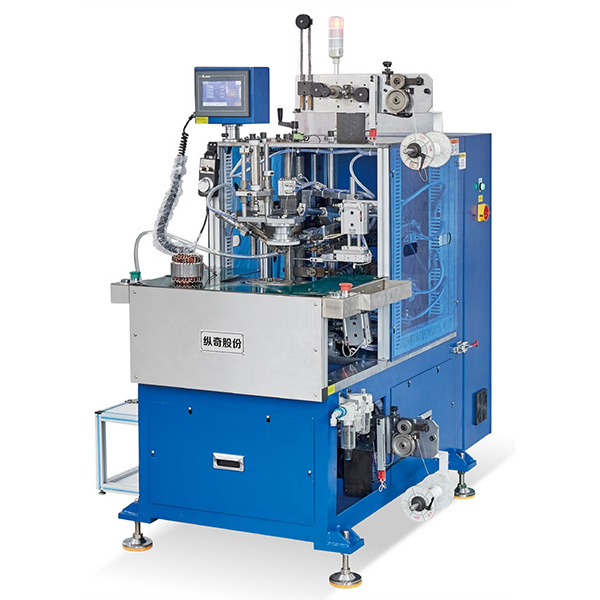Bdtronic recently designed a fully automated production line for potting the shift ring on a motor stator. Photo courtesy Bdtronic GmbH
The line consists of an infrared preheating station; a cleaning station; a low-pressure plasma unit for surface activation; a B5200-V vacuum dispensing cell with a dynamic mixing head and three-chamber vacuum technology; an infrared curing station; a conveyor; and a loading and unloading station equipped with a six-axis robot. Photo courtesy Bdtronic GmbH Three-Phase Motor Stator Manufacturing

The dispensing cell processes a highly filled two-component epoxy. A dynamic mixing system guarantees the highest mixing quality, even with large viscosity differences, difficult mixing ratios and processing times of less than three minutes. Photo courtesy Bdtronic GmbH
Extensive testing determined that a dispensing rate between 1 and 3 grams per second was optimal for series production. Photo courtesy Bdtronic GmbH
Numerous dispensing applications are required in the production of traction motors for electric and hybrid vehicles. Bus bar potting is one of them.
Two main types of AC motors are used in electric vehicles: asynchronous motors (ASM) and synchronous motors with permanent magnets (PSM). In both cases, bus bars at the ends of the windings of the stator establish switching connections between individual windings. These bus bars must be encapsulated to insulate them from the cooling medium of the motor. The encapsulation must be carried out with high precision to avoid performance losses due to a reduced cooling effect.
German automation and dispensing technology company bdtronic recently designed a fully automated production line for potting the shift ring on a motor stator. Built for a major German Tier 1 automotive supplier, the line combines different technologies, achieves the shortest possible cycle time, and meets the customer’s requirement for a small footprint and efficient use of resources.
The line consists of an infrared preheating station; a cleaning station; a low-pressure plasma unit for surface activation; a B5200-V vacuum dispensing cell with a dynamic mixing head and three-chamber vacuum technology; an infrared curing station; a conveyor; and a loading and unloading station equipped with a six-axis robot. RFID technology and a manufacturing execution system track assemblies throughout production.
The dispensing cell processes a highly filled two-component epoxy. This material is used wherever protection against heat and the elements is required. The epoxy must be precisely mixed and metered at a specific mixing ratio and process temperature. The dynamic mixing system guarantees the highest mixing quality, even with large viscosity differences, difficult mixing ratios and processing times of less than three minutes.
The material preparation system ensures that the resin is continuously circulated, tempered and bubble-free under vacuum (below 10 millibars). The material preparation system does not have to be stopped for refilling, so the system can operate continuously if needed.
The material is dispensed volumetrically by a pump with eccentric screws developed by bdtronic. A temperature management system with different heating zones in the material feed and mixing head ensure optimal dispensing. Extensive trials at bdtronic’s Technology Center determined that a dispensing rate between 1 and 3 grams per second was optimal for series production.
Parts with three-dimensional contours can be accommodated thanks to a precise, servo-driven gantry system inside the vacuum chamber.
The vacuum plasma unit was integrated so that the temperature loss of the preheated components is as low as possible. After potting the stator rings, the epoxy is annealed in the infrared curing unit, so the components can be handled for further processing.
Infrared technology offers several advantages. Four preheating positions can be used, and processing time is minimized. The unit has a relatively small footprint, and energy consumption is significantly less than convection ovens.
To see a video of the system, click here: https://youtu.be/ZdWwmvVn9fU.
For more information on automation and dispensing technology, click www.bdtronic.com.
Carolin Gachstetter // Marketing Manager // Bdtronic GmbH // Weikersheim, Germany
You must have JavaScript enabled to enjoy a limited number of articles over the next 30 days.
On Demand Connecting shop floor tools to a manufacturing execution system is critical to error-proofing assembly processes, improving quality control, and lowering defect and scrap rates. Join Torrence Williams, Partnerships Manager for Pico MES, and Dan Smith, VP of Sales for Kolver Tools, as they discuss an easier path for manufacturers to start connecting their factory floor.
On Demand This topic is something that challenges each of us every day that we go to work. This talk is about change and why it works and why it fails. It is focused on manufacturing facilities, because that is where the author has spent most of his working life.
Copyright ©2024. All Rights Reserved BNP Media.

Motor Stator Automatic Production Line (Robot Mode 2) Design, CMS, Hosting & Web Development :: ePublishing